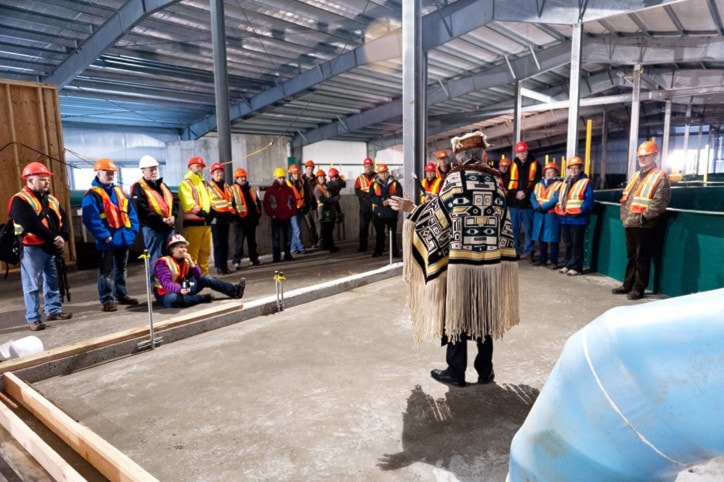PORT McNEILL—Almost one year ago, 'Namgis Chief Bill Cranmer blessed the ground on what was to become North America's first land-based, closed-containment atlantic salmon farm near the banks of the Nimpkish River.
On Monday afternoon, he returned for the same ceremony at the now nearly complete facility.
"That is a prayer song to bless all the people working here," Cranmer, in full ceremonial regalia, said after singing before an assemblage of K'udas Limited Partnership board members, tribal councillors and a few curious construction workers still applying finishing touches to the huge steel building just off Highway 19.
"That's a blessing song that's been handed down from generation to generation. It's a special feeling to do that here, thinking of the old people who used to do it in this area."
The $8.5 million, 'Namgis-owned project is situated on First Nation's traditional territory, in the vicinity of a pre-contact Kwakwakw'wakw village. K'udas, a Kwa'kwala word meaning "place of salmon", will become just that next month when the first cohort of 23,000 atlantic salmon smolt are placed in the farm's quarantine tank.
After growing from about 100 grams each to 650-750 grams over a four-month period, the fish will move on to a series of 500-metre grow-out tanks in the recirculating aquaculture system (RAS), where they will spend an additional 8-10 months to reach their market size of four to five kilograms each.
Before the end of the year, those smolt will be market-ready, farm-grown salmon free of any pesticides, antibiotics or interaction with wild salmon stocks and other marine life.
"We'll take out our first harvest in seven to eight months," said Cathal Dinneen, plant operations manager. "The first harvest won't be four to five kilo fish, they'll be around 2-3 kilos. But eventually we'll be growing out all the fish to full size, and we'll be harvesting every two weeks."
With five of the massive grow-out tanks, the facility is expected to produce 470 tonnes of salmon each year. But the building is just the first module in what could become a five-module plant producing up to 2,500 tonnes of farmed salmon a year.
The aim of the project is to prove land-based salmon farming is an economically viable way to grow and market high-quality fish. The RAS technology itself is proven, with operating plants in Europe and Iceland and one in West Virginia, in the U.S., growing turbot.
But the 'Namgis First Nation specifically wanted to prove the viability of the system as a way to replace open-net pen farming in British Columbia waters, which has come under fire from critics for spreading disease among wild salmon stocks and its impacts to the marine environment from the discharge of waste laced with antibiotics and pesticides.
The fish in the 'Namgis closed-containment system will be grown in fresh water provided by a natural artesian aquifer. The smolts in the quarantine tank will be treated only by a specialized bacteria, housed in a separate biofilter unit, which will remove the metabolites produced by the salmon to keep their water free of toxins.
"We've been growing the bacteria for the last month," said Dinneen. "Because we have fish arriving in a few weeks, we needed the bacteria before they get here. It's done; the biofilters are fully seeded ahead of schedule and we're ready to go."
Even as the board and council toured the plant Monday, a large electrical transformer was being installed at one side of the building. A generator has been handling the pumping of the biofilter until now, but, Dineen said, a full hydo connection is expected late this week or next week at the latest. The final construction remaining involves the monitoring and alarm systems, part of which is completed, and installation of partition walls to separate the quarantine unit and the grow-out units in the biosecure facility.
The first smolts, delivered through a contract with Marine Harvest, are expected to be delivered between March 10-20.
